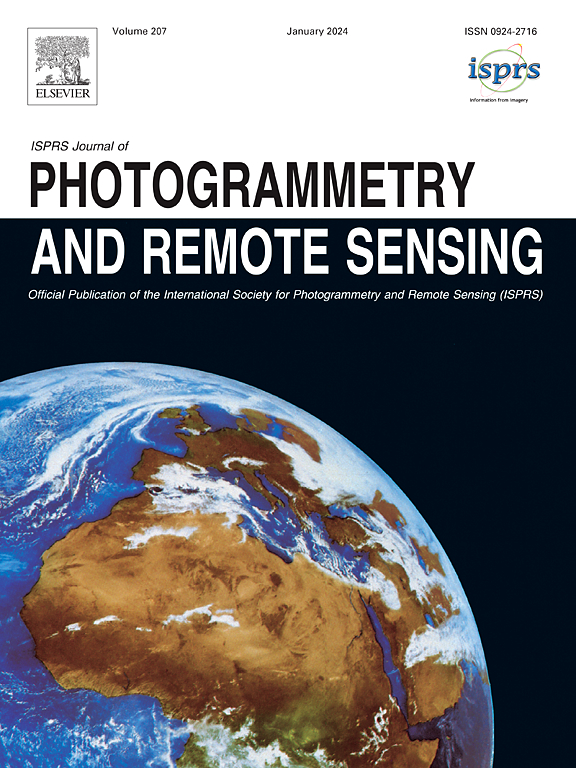3D semantic segmentation: Cluster-based sampling and proximity hashing for novel class discovery
IF 10.6
1区 地球科学
Q1 GEOGRAPHY, PHYSICAL
ISPRS Journal of Photogrammetry and Remote Sensing
Pub Date : 2025-03-20
DOI:10.1016/j.isprsjprs.2025.03.001
引用次数: 0
Abstract
Novel Class Discovery (NCD) in 3D semantic segmentation is crucial for applications requiring the ability to learn and segment previously unknown classes in point cloud data, such as autonomous driving and urban planning. Traditional 3D semantic segmentation methods often build upon a fixed set of known classes, which restricts their ability to discover classes not covered in the original training data. To overcome these limitations, we propose a novel framework specifically designed for NCD in 3D semantic segmentation. The framework integrates the Voxel-Geometry Data Integration module, the Cluster-based Representative Sampling module, the Neighborhood Spatial Partitioning module, and the Spatial Feature Attention Mechanism. These modules collectively enhance the model’s capability to integrate spatial and geometric information, identify key representative points, map neighborhoods effectively, and synthesize localized and global features. Experimental results on benchmark datasets, including S3DIS, Toronto-3D, SemanticSTF, and SemanticPOSS, demonstrate the proposed method’s superior performance in discovering novel classes and improving overall segmentation quality. For instance, in the SemanticPOSS- split, the method achieves a mean Intersection over Union (mIoU) of 43.68% for novel classes, compared to 35.70% achieved by NOPS. These results highlight the framework’s effectiveness in handling complex scenes and its potential to advance NCD in 3D semantic segmentation.
3D语义分割:基于聚类的采样和邻近散列新类发现
3D语义分割中的新颖类发现(NCD)对于需要学习和分割点云数据中未知类的应用至关重要,例如自动驾驶和城市规划。传统的3D语义分割方法通常建立在一组固定的已知类的基础上,这限制了它们发现原始训练数据中未涵盖的类的能力。为了克服这些限制,我们提出了一个专门为NCD在3D语义分割中设计的新框架。该框架集成了体素-几何数据集成模块、基于聚类的代表性采样模块、邻域空间划分模块和空间特征注意机制。这些模块共同增强了模型整合空间和几何信息、识别关键代表性点、有效绘制邻域以及综合局部和全局特征的能力。在S3DIS、Toronto-3D、SemanticSTF和SemanticPOSS等基准数据集上的实验结果表明,该方法在发现新类和提高整体分割质量方面具有优异的性能。例如,在SemanticPOSS-40分割中,该方法对新类实现了43.68%的平均交联(Intersection over Union, mIoU),而NOPS实现了35.70%。这些结果突出了该框架在处理复杂场景方面的有效性,以及它在3D语义分割中推进NCD的潜力。
本文章由计算机程序翻译,如有差异,请以英文原文为准。
求助全文
约1分钟内获得全文
求助全文
来源期刊

ISPRS Journal of Photogrammetry and Remote Sensing
工程技术-成像科学与照相技术
CiteScore
21.00
自引率
6.30%
发文量
273
审稿时长
40 days
期刊介绍:
The ISPRS Journal of Photogrammetry and Remote Sensing (P&RS) serves as the official journal of the International Society for Photogrammetry and Remote Sensing (ISPRS). It acts as a platform for scientists and professionals worldwide who are involved in various disciplines that utilize photogrammetry, remote sensing, spatial information systems, computer vision, and related fields. The journal aims to facilitate communication and dissemination of advancements in these disciplines, while also acting as a comprehensive source of reference and archive.
P&RS endeavors to publish high-quality, peer-reviewed research papers that are preferably original and have not been published before. These papers can cover scientific/research, technological development, or application/practical aspects. Additionally, the journal welcomes papers that are based on presentations from ISPRS meetings, as long as they are considered significant contributions to the aforementioned fields.
In particular, P&RS encourages the submission of papers that are of broad scientific interest, showcase innovative applications (especially in emerging fields), have an interdisciplinary focus, discuss topics that have received limited attention in P&RS or related journals, or explore new directions in scientific or professional realms. It is preferred that theoretical papers include practical applications, while papers focusing on systems and applications should include a theoretical background.
 求助内容:
求助内容: 应助结果提醒方式:
应助结果提醒方式:


